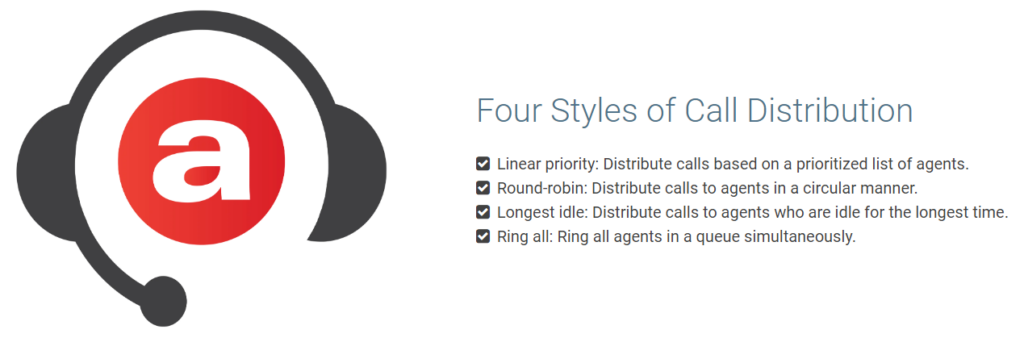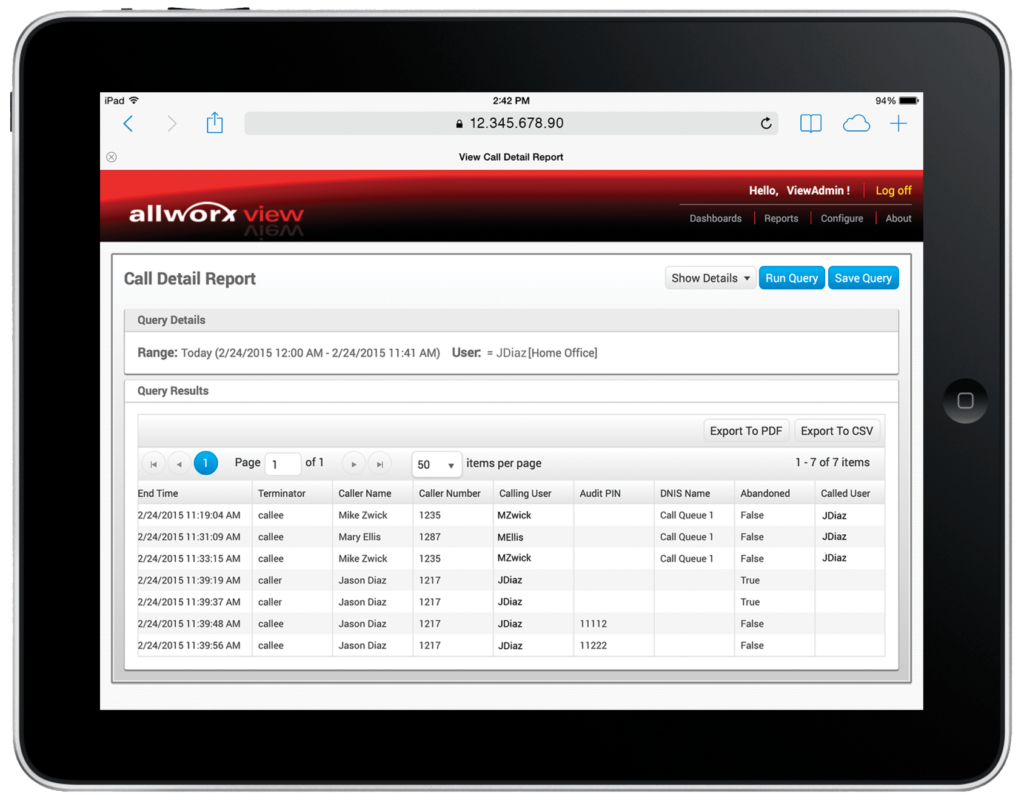VoIP phone systems (Voice over Internet Protocol) are the new way to go when it comes to business communications. VoIP uses the internet to make and receive calls, rather than traditional landlines like a normal telephone. What makes VoIP so great? Well, VoIP offers a myriad of perks that regular phones do not and when leveraged correctly, businesses can easily reap the benefits of such a managed phone system. A VoIP call center is the same as a normal call center that handles inbound and outbound calls for an organization. VoIP call centers rely solely on VoIP phone systems and run entirely over the internet. Call centers receive and/or make lots of calls, so having a phone system that won’t slow them down is a number one priority. VoIP phones are specifically designed for busy environments to save time, increase productivity, and ensure that no calls get overlooked.
Call Center vs. Contact Center
Although commonly mistaken to be the same thing, call centers and contact centers are not identical. Call centers strictly use phone calls as a way to interact with customers. A contact center uses multiple channels of communication for outreach and are not just limited to phone use. This may include outlets like social media and email to share information. These centers might focus exclusively on inbound or outbound communications, or they will be “blended” and handle a mix of incoming and outgoing calls. VoIP can benefit both call centers and contact centers.

Working in a Call Center Environment
Ring, ring! When you think of a call center, you might imagine a massive room full of cubicles, with an employee, a phone and a headset at every desk, and the atmosphere is filled with noise: constant ringing, talking, and the sound of phone buttons being pressed. The main objective of working in a call center is to get those calls in and out and more importantly, keep the caller’s attention, whether it’s to sell a product or service or offer support. Without VoIP, the scenario could be especially overwhelming—phones ringing endlessly and unintentionally missed calls could make for quite the hectic atmosphere. VoIP call centers operate to make the job more efficient and profitable.
Source: Allworx® | Verge™ IP Phone Series User Guide
Call Center Burnout is Very Real
Burnout occurs in many different types of workplaces and is something that companies have grown more mindful of in recent years, and are actively seeking to reduce. Call center burnout is a result of compounded stress; this usually means someone has been stressed for too long, didn’t take time to recover properly (or failed to implement routine self care in between work) and continued to push forward despite it. Call centers are high-stress environments that are constantly buzzing—some people thrive in them, while others don’t and can get worn down easily. Burnout can also be a result of unrealistic or unclear expectations, poor work-life balance, lack of socialization at work or outside of work, sleep deprivation and so much more. (There could be countless triggers. We’re complex creatures, after all!) This is a huge issue for call centers especially because burned out employees usually don’t have exemplary performance, and their work will most likely suffer as a result. Companies are realizing that the introduction of VoIP in the workplace actually helps to reduce issues associated with employee burnout. It could be that powerful in improving productivity and workflow.
Customer Service Training Can Be Difficult
Especially in large call centers where it’s hard to monitor every employee at once, customer service training can be a challenge but good customer service can make all the difference. Positive first impressions, polite conversations, and the ability to keep a cool head and handle challenging situations properly and respectfully, are some of the attributes that will make consumers far more willing to engage in a phone call with an employee.
When customers are calling, perhaps frustrated about a faulty device or their delayed shipment, they want someone with good customer service and communication skills on the other end of the line. Having excellent service training is foundational to call center success, which is something that VoIP can help with!
Low Customer Retention
Think about the amount of times you’ve gotten frustrated with long wait times or missed calls from a service center. Customer retention is something that matters for call centers but may be difficult to achieve. It’s due to the many shortcomings of a standard phone system that lacks all of VoIP’s excellent features.
VoIP-Specific Features that are Great for Call Centers
Many of VoIP’s key features were designed to benefit any business or organization but call centers will undoubtedly reap the most rewards.
Automatic Call Distribution (ACD)
This is a must have for call centers! ACD is a way to evenly distribute incoming calls to the employees in a call center. This is a great feature to ensure that every employee is getting their share of work. AllWorx, for example, has four different types of call distribution styles: linear priority, round-robin, longest idle, and ring all. Depending on the size and the type of business, you might choose to use one type of ACD style over the others.
“Linear priority” will distribute calls based on a prioritized list of agents. Perhaps this list has the manager first, followed by the assistant manager. Incoming calls will go to the manager. If that individual is busy, the call will go to the next person in line, the assistant manager. “Round-robin” distributes calls in a circular manner, starting with one person and then going to the next. If that person is busy, they will be skipped over in that round-robin, and the call will go to the next person in the circle. The “Longest idle” gives the call to the agents who have not taken calls or been on-call for the longest time. “Ring all” distributes the call to all of the agents at once. These types of call distribution styles may work better or worse for different companies.

Call Queue: Don’t Miss Any Calls!
Making and receiving all calls is critical for call centers; after all, the main wave of their business relies on telephone call communication. VoIP’s feature, the “queue,” will place incoming calls in an answering line if all of the attendants are unavaliable. Callers can then wait, while listening to some music or promotions perhaps, before the next available representative picks up the call. With VoIP, your call center won’t miss any incoming calls, which means more potential for business. It’s a win!
Call Supervision (Call Monitoring)
The “Call Supervision” feature, popularly known as Call Monitoring, might conjure thoughts of Big Brother but it can actually alleviate a lot of stress for both call center supervisors as well as employees. This is a feature in which a third-party can listen to a conversation and observe how it’s going, as well as join the conversation. Call monitoring can be great for employee training to assess how new workers are handling calls and create pointers for improvement. It’s also helpful for passing a call to another worker while staying on the line, allowing employees to introduce the new person to the customer, before they disconnect from the line. This provides comfort to customers, making them feel more certain that their needs will be taken care of. Call Supervisor has three modes: Barge In, Whisper or Silent Monitor.
- Barge In: Everybody hears everybody, all people on the line can interact
- Whisper: The supervisor can speak to the attendee on the call but the caller cannot hear the supervisor
- Silent Monitor: No one on the call has any idea that anyone is listening in
Call Activity Reports, Metrics and Analytics
Another VoIP feature that’s great for call centers are the call activity reports, metrics and analytics. This will include real-time and historical data including total calls, inbound calls, outbound calls, total talk time (for both inbound and outbound as well), and more. This can help your organization rate the effectiveness and monitor how well the call center is operating.

Benefits of VoIP for Call Centers
VoIP offers a lot of benefits for call centers. Beyond the key customizable features, call centers will receive a lot of perks when they use voice over IP.
Flexibility
Many VoIP manufacturers are raving about how “flexible” their systems are but what does this actually mean? VoIP flexibility refers to the phone system’s ability to offer services across a wide range of geographic locations. So for call centers, flexibility is key: employees can work from wherever and still make and receive calls. VoIP’s flexibility makes a great solution for hybrid and remote workplaces.
Cost Savings
When compared to a typical landline phone, having VoIP equals a lot of cost savings. While there is an initial upfront cost to cover equipment and installation, VoIP call centers are then only left with a predictable, recurring monthly fee for support. Compared to the cost of the time actually spent on calls (which, let’s be honest, would be staggering for call centers), and you can see how this helps call centers save money in the long-term. Perhaps the call center is a nonprofit that needs to work around a rather slim budget. The cost savings of VoIP make it a great choice so that your charitable organization can continue working on its mission with a successful outreach program. VoIP is an excellent solution for nonprofit organizations.
Scalability
When your call center first starts out, it’s likely to be smaller than it will be in, let’s say, two years’ time. A growing business is exciting but naturally, requires a lot of planning. Not only would the cost savings be significant but scaling your office and equipment will be far simpler and easier when it comes to VoIP. Less work equals less stress and you can save yourself a headache throughout the various stages of growth by implementing VoIP much earlier on.
Efficiency
The need to maximize efficiency and productivity are endlessly emphasized at call centers. Recieviewing and/or making as many high quality calls as possible, and prioritizing customer satisfaction, is key to call center success. With VoIP, your phone system can be structured in such a way that ensures peak performance of not only your communications system but also your employees.
No More Missed Calls
Missed calls can mean missed opportunities and lost business for call centers, and regularly missed calls would be a huge cause for concern. You can now eliminate missed calls almost entirely with VoIP’s automatic call distribution feature. This will ensure that calls are going through a cycle of employees and aren’t skipped because some of them are busy with another caller.
Get Data Insights
While helpful for every business, data insights is something that will be particularly compelling to call centers because how well they do is directly correlated to employee performance. Inbound and outbound calls are essential for this kind of business model and understanding these analytics can help supervisors better train employees, improve the customer service experience overall, as well as assist with customer retention. A cloud-based VoIP software will give users insight into precisely these types of things, such as caller experience, speech analytics and even call quality issues. With a traditional phone line, these types of telephone experience issues wouldn’t be nearly as transparent.
Managed VoIP Installation for Call Centers
Getting your call center equipped with a new VoIP system is (luckily) quite easy! VoIP connects to the internet, so you’ll be able to connect your new phone system to already existing ethernet cables. Depending on the type of VoIP communication phone system your organization is seeking, you might need different amounts and levels of hardware. Lots of VoIP phone calls are made with typical desk phones and headsets (if desired). This is known as on-premise VoIP. Businesses may also opt for hosted VoIP (also known as cloud-based), which is a fantastic option for remote and hybrid work, and doesn’t require any hardware or onsite maintenance. However, hosted VoIP doesn’t offer nearly as much customization, and the costs of on-premise VoIP are typically cheaper. Computero doesn’t just offer VoIP phone systems, we use them ourselves and can attest to their reliability, scalability and affordability.





0 Comments